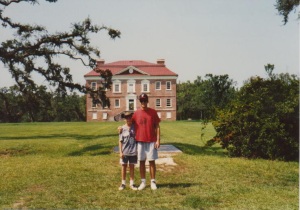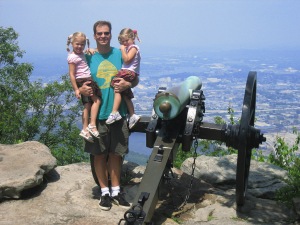Voted the Best Place to See by Condé Nast Traveler.

Guest posting by Bob Beatty, Vice President for Programs, American Association for State and Local History
I have been a history geek for as long as I can remember. It is a mantle I wear proudly and one that was confirmed in various Beatty family vacation photos I recently looked through. There are images of me in costume in an old time photo booth, standing by cannons at various sites, and looking at the Gettysburg statue of General John Buford, an ancestor.
Our vacations could be tracked in the family station wagon trips we made from south Florida through the Southeast and up the Eastern Seaboard. We took trips to St. Augustine, Savannah, Charleston, Richmond, the Civil War battlefields in and around Northern Virginia, and to Gettysburg. We visited forts, antebellum homes, battlefields, just about anything historic that I had found in some random guidebook or had seen on one of the brown signs by the highway (you follow the brown signs too, right?).
I developed a very deep and personal connection to historic sites through these visits and a love for not only the sites and artifacts, but for museums and cultural institutions as a whole. I felt a connection to the history I so loved to read in books that continues in me to this very day.
In the 1980s, I visited Drayton Hall in South Carolina for the first time. I remember initially being unimpressed by its bare-bones interpretation. I was so used to antebellum homes dressed out in all their finery that Drayton Hall’s interpretation and emphasis on historic preservation was initially lost on me.
But after spending an afternoon there, I was soon hooked. I recognized that history doesn’t have to be gussied up to be interesting or to convey something important about the past, an idea I have carried with me philosophically ever since. And to this day, I still covet the rice spoon that my mother got on that visit.
 A few years later, we visited again (shown in the attached photo). I was in my sophomore year of college and a history major. While not yet sure what the heck I was going to do when I finished school, my deep and abiding connection to history and historic places remained. I did not imagine that one day I might be in a position to impact others like I had been impacted at Drayton Hall.
A few years later, we visited again (shown in the attached photo). I was in my sophomore year of college and a history major. While not yet sure what the heck I was going to do when I finished school, my deep and abiding connection to history and historic places remained. I did not imagine that one day I might be in a position to impact others like I had been impacted at Drayton Hall.
My parents initially instilled in me the importance of preservation of historic and natural resources. Probably the most tangible lesson I learned about preservation came during a trip to Florida Caverns State Park (if memory serves). The caverns were lit, emphasizing the beauty of the natural formations. As we toured, our guide implored us not to touch anything. “You’ll have the chance at the end of the tour.” And have our chance we did. At the end, there was one stalagmite/stalactite formation that had grown together into a single column (I’ve since forgotten what that’s called, I got a “C” in geology in college). The guide encouraged us to touch it. It was black and disgusting.
This taught me a lesson that has remained with me for almost 30 years now. Without careful care or handling, our precious past would cease to exist or become sullied and almost unrecognizable.
Twenty-five years after the cave tour Marianna, Florida, and over 25 years since my first visit to Drayton Hall, I now find myself working at the American Association for State and Local History. I am now in a position to affect change and advocate for history organizations and (hopefully) make a difference in a real and meaningful way through AASLH’s programs and publications.
 In many ways, my passion for my work comes directly from the deep connections to the past I made at sites like Drayton Hall. It is these “plant the seed” moments that we at historic sites and museums seek in our education and interpretive programs, yet we often have so few instances that we can point to that demonstrate how that seed has taken hold. It has taken hold in me in a myriad of ways, not least of which is my career choice, and, of course, bringing my young daughters to historic sites on a regular basis (see the photo of us at Lookout Mountain National Park a few years back).
In many ways, my passion for my work comes directly from the deep connections to the past I made at sites like Drayton Hall. It is these “plant the seed” moments that we at historic sites and museums seek in our education and interpretive programs, yet we often have so few instances that we can point to that demonstrate how that seed has taken hold. It has taken hold in me in a myriad of ways, not least of which is my career choice, and, of course, bringing my young daughters to historic sites on a regular basis (see the photo of us at Lookout Mountain National Park a few years back).
So don’t overlook the meaningful connections you may be making with your audiences. They may simmer for years and manifest themselves in one’s career path and life’s work.
Do you have a memorable moment of inspiration at a historic site? How do you remember your childhood visits to historic sites or museums? Please share your experiences with us.